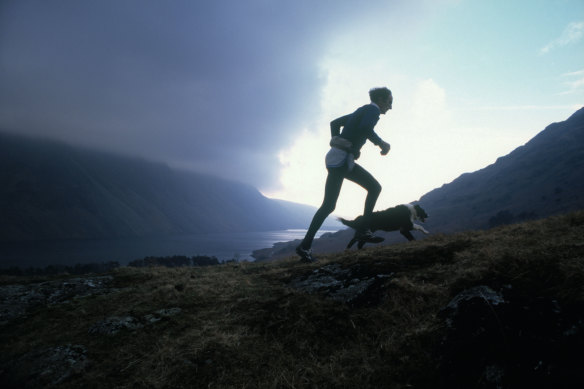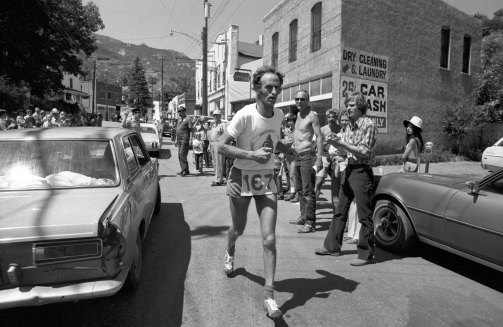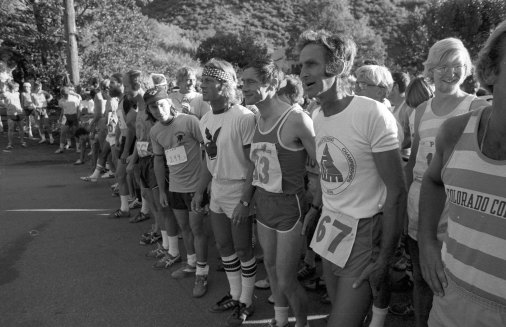English king of racing up mountains
The “Iron Man” of fell running – the somewhat preposterous English sport of off-trail mountain racing – was Joss Naylor, a sheep farmer who, during multi-day marathons traversing rugged terrain, endured the loss of all 10 toenails, skinning his soles and being kicked by an irritated cow.
In competitions that sometimes lasted a week, he survived on scone-like cakes and black currant juice with a dash of salt and cod liver oil that he swilled straight from the bottle – “like whiskey,” he once said.

Farmer and fell runner Joss Naylor running up Wasdale with courage determination in the Lake District Cumbria.Credit: Alamy
Naylor died in a care home in Gosforth, a village in Cumbria, northwest England. He was 88. His daughter Gillian Naylor said the cause was complications of several recent illnesses, including a stroke.
His feats running the fells – the term in northern England for hills and mountains – defied common sense and earned him multiple nicknames, including “Iron Man” and “King of the Fells.”
In 1971, Naylor became the sixth person to conquer the Bob Graham Round – a 24-hour challenge to finish a 66-mile (106 kilometres) trek over 42 peaks in Cumbria’s Lake District. He overachieved, topping 61 peaks in 23 hours 37 minutes.
The next year, he crossed 63 peaks in the challenge, followed by 72 in 1975 – both times in under 24 hours.
Still running at age 50 in 1986, he completed the Wainwright Round, a series of 214 summits, in just over seven days, setting a record that stood until 2014. (He would have finished faster had he not stopped to save a lamb stuck in mud.)
“To say that Joss Naylor was a famous fell runner is like saying that Muhammad Ali was a well-known boxer, or Emil Zátopek a successful Olympian,” Richard Askwith, a British journalist, wrote for Runner’s World. “It’s true, but it misses the story that matters. Naylor was a colossus who not only took his sport to breathtaking new heights but (like Ali and Zátopek) did so with a charisma and greatness of heart that brightened the lives of all who came into contact with him.”
That Naylor could climb hills, let alone mountain peaks, was seemingly improbable. Growing up on a farm, he sustained a series of knee and back injuries, beginning with a reprimand that his mother delivered with her foot.
“I got a kick up the backside that went wrong,” he told the News & Star, an English newspaper, in 2021. “I’d have been giving her cheek. I was eight or nine, got caught in the wrong position, and I could feel something wasn’t right.”
He eventually needed back surgery. A few months later, he injured his back again, this time while hopping a fence. When he was 19, doctors removed all of the cartilage from one of his knees. More back injuries followed, and he had two discs removed when he was 22. Doctors pronounced him unfit for national service, told him to avoid strenuous activity and prescribed a corset.
Naylor ignored the doctors, tossed the corset and went back to herding sheep in Wasdale, the rural parish in Cumbria where his family farmed. In 1960, Wasdale held a fell running competition.
“I hadn’t entered,” he wrote in The Sunday Times Magazine in 1976. “I just joined in when they set off, in my working boots. I was first to the first checkpoint, joint first to the second, then I fell down with cramp in both legs. I came in last in lots of races, passing out with the pain at the barrier.”
He kept racing, though. And he kept getting better.

Joss Naylor in action during the Pikes Peak Marathon in 1975.Credit: Sports Illustrated via Getty Images
In 1971, after the Bob Graham Round, he took on the National Three Peaks Challenge, which involved racing up the highest peaks in England, Scotland and Wales in 24 hours, including driving time between the mountains. He finished in just under 12 hours. Nobody has beaten that time.
Naylor suffered gruesome injuries over the years, including in 1976, when he lost all of his toenails and the skin on the bottom of his feet during a two-day race. Animals were also problematic. In a 1970 race that he was poised to win, he dropped into second place after being kicked by a cow.
But pain – in his back or his feet, or from ornery farm animals – never deterred him. As his wins piled up, so did his fame, but only in the hills and valleys of England’s rural countryside. Hundreds of fell runners attended his funeral, running eight miles up the valley near his home in his honour.
“He never won an Olympic medal, or earned a penny from his sporting achievements, or did anything much in the public gaze,” Askwith wrote. “His greatness was realised in wild, remote places.”
Joseph Naylor was born on February 10, 1936, in Wasdale Head, Cumbria, the youngest of four sons of Joe Naylor, a shepherd, and Ella (nee Wilson) Naylor.
His family’s 140-acre tenant farm didn’t have electricity. Every day, Naylor – known as Joss – climbed up and down the local mountains herding sheep. The days were monotonous but quietly joyous. As he grew older, his parents’ daily routine became his own.

Naylor lines up alongside racers at the start of the Pikes Peak Marathon in 1975.Credit: Getty
“The first job of the day is milk the cow,” he wrote. “I do it by hand. She gives about three gallons, which I put in the fridge to cool. We drink yesterday’s for our cereal.”
He had more than 1000 sheep, and he herded them with six dogs – Scamp, Laddy, Bob, Gip, Speck and Patch.
“My dogs are very tough,” he wrote. “They keep the sheep moving and stand no nonsense.”
The days before races were especially laborious.
“I have to try to get ahead with my work,” he wrote. “You can’t get anyone to look after sheep these days. Nobody’s daft enough. There’s no money in sheep farming.”
Naylor married Mary Downie in 1963. In addition to his wife, he is survived by their children, Gillian, Paul and Susan Naylor, and 10 grandchildren.
After finishing work for the day, Mr Naylor would head for the cool water in a nearby stream.
“In the summer I get in up to my waist and give myself a good scrub,” he wrote. “Perhaps once a fortnight I might have a bath. Perhaps once a month.”
Dinner was always at 6.30 pm.
“Bit of mutton, bit of beef, whatever the missis has got,” Naylor wrote. “Then a cup of tea.”
The New York Times